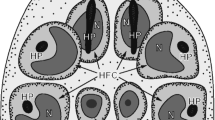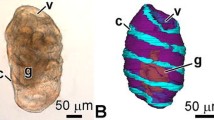Summary
The larval stage of Polypodium hydriforme is planuliform and parasitic inside the growing oocytes of acipenserid fishes. The larva has inverted germ layers and a special envelope, the trophamnion, surrounding it within the host oocyte. The trophamnion is a giant unicellular provisory structure derived from the second polar body and performing both protective and digestive functions, clearly a result of adaptation to parasitism. The trophamnion displays microvilli on its inner surface, and irregular protrusions anchoring it to the yolk on its outer surface. Its cytoplasm contains long nuclear fragments, ribosomes, mitochondria, microtubules, microfilaments, prominent Golgi bodies, primary lysosomes, and secondary lysosomes with partially digested inclusions.
The cells of the larva proper are poorly differentiated. No muscular, glandular, neural, interstitial, or nematocyst-forming cells have been found. The entodermal (outer layer) cells bear flagella and contain rough endoplasmic reticulum; the ectodermal (inner layer) cells lack cilia and contain an apical layer of acid mucopolysaccharid granules. The cells of both layers contain mitochondria, microtubules, and Golgi bodies; their nuclei display large nucleoli with nucleolonema-like structure, decondensed chromatin, and some perichromatin granules. At their apical rims, the ectodermal cells form septate junctions; laterally, the cells of both layers form simple contacts and occasional interdigitations. The lateral surfaces of entodermal cells are strengthened by microtubules.
Similar content being viewed by others
References
Barka T, Anderson P (1962) Histochemical methods for acid phosphatase using hexazonium pararosanilin as coupler. J Histochem Cytochem 10:741–753
Bodo F, Bouillon J (1968) Etude histologique du développement embryonnaire de quelques hydromeduses de Roscoff: Phialidium hemisphaerium (L.), Obelia sp. Péron et Lesueur, Sarsia eximia (Allman), Podocoryne carnea (Sars), Gonionemus vertens Agassiz. Cahiers Biol Marine 9:69–104
Dogiel VA (1940) New finding places and new hosts of Polypodium hydriforme. (In Russian). Zool Zhurnal (Moscow) 19:321–323
Gibbins JR, Tilney LG, Porter KR (1969) Microtubules in the formation and development of the primary mesenchyme in Arbacia punctulata. I. The distribution of microtubules. J Cell Biol 41:201–226
Iwanowa-Kazas OM (1961) Essays on comparative embryology of the Hymenoptera. (In Russian). Leningrad Univ Press, Leningrad
Kościelski B, Kościelska MK, Szroeder J (1978) Ultrastructure of the polygerm of Ageniaspis fuscicollis. Zoomorphologie 89:279–288
Lipin AN (1911) Über ein neues Entwicklungsstadium von Polypodium hydriforme Uss. Zool Anz 37:97–99
Lyons KM (1973) Collar cells in planula and adult tentacle ectoderm of the solitary coral Balanophyllia regia (Anthozoa, Eupsammiidae). Z Zellforsch 145:57–74
Raikova EV (1958a) The life cycle of Polypodium hydriforme Ussov (Coelenterata). (In Russian, English summary). Zool Zhurnal (Moscow) 37:345–358
Raikova EV (1958b) A histochemical study of the parasitic larva of Polypodium hydriforme Ussov (Coelenterata). (In Russian). Doklady Akad Nauk SSSR 121:549–552
Raikova EV (1960) Morphological and cytochemical investigation of parasitic stages of the life cycle of Polypodium hydriforme Ussov (Coelenterata). (In Russian). Tsitologiya (Leningrad) 2:235–251
Raikova EV (1961) Development of the male gonads and spermatogenesis in Polypodium hydriforme. (In Russian). Tsitologiya (Leningrad) 3:528–544
Raikova EV (1963) Morphological and cytochemical changes in the oocytes of the sterlet and the sturgeon under the effect of parasitizing of Polypodium hydriforme Ussov (Coelenterata). (In Russian). Doklady Akad Nauk SSSR 152:985–988
Raikova EV (1964a) Unicellular parasitic stages of the life cycle of Polypodium hydriforme Ussov (Coelenterata). (In Russian, English summary). Zool Zhurnal (Moscow) 43:409–412
Raikova EV (1964b) Early parasitic stages of the life cycle of Polypodium hydriforme Ussov (Coelenterata). (In Russian). Doklady Akad Nauk SSSR 154:742–743
Raikova EV (1965) A cytophotometric study of the DNA content in the cell nuclei of Polypodium hydriforme Ussov (Coelenterata) at various stages of its life cycle. (In Russian, English summary). Zhurnal Obsch Biol (Moscow) 26:546–552
Raikova EV (1973) Life cycle and systematic position of Polypodium hydriforme Ussov (Coelenterata), a cnidarian parasite of the eggs of Acipenseridae. Publ Seto Marine Biol Lab 20 (Proc. 2nd Internat. Symp. on Cnidaria): 165–173
Suppes VC, Meyer FP (1975) Polypodium sp. (Coelenterata) infection of paddlefish (Polyodon spathula) eggs. J Parasital 61:772–774
Tilney LG, Gibbins JR (1969) Microtubules in the formation and development of the primary mesenchyme in Arbacia punctulata. II. An experimental analysis of their role in development and maintenance of cell shape. J Cell Biol 41:227–250
Ussow M (1887) Eine neue Form von Süsswasser-Coelenteraten. Morphol Jahrb 12:137–153
Van de Vyver G (1964) Étude histologique du développement d'Hydractinia echinata (Flem.). Cahiers Biol Marine 5:295–310
Van de Vyver G, Bouillon J (1969) Étude du développement embryonnaire et de l'histogenèse de Eleutheria dichotoma (de Quatrefages) (Anthomeduse Eleutheriidae). Ann Embryol Morphogen 2:317–327
Author information
Authors and Affiliations
Rights and permissions
About this article
Cite this article
Raikova, E.V. Morphology, ultrastructure, and development of the parasitic larva and its surrounding trophamnion of Polypodium hydriforme Ussov (Coelenterata). Cell Tissue Res. 206, 487–500 (1980). https://doi.org/10.1007/BF00237977
Accepted:
Issue Date:
DOI: https://doi.org/10.1007/BF00237977




